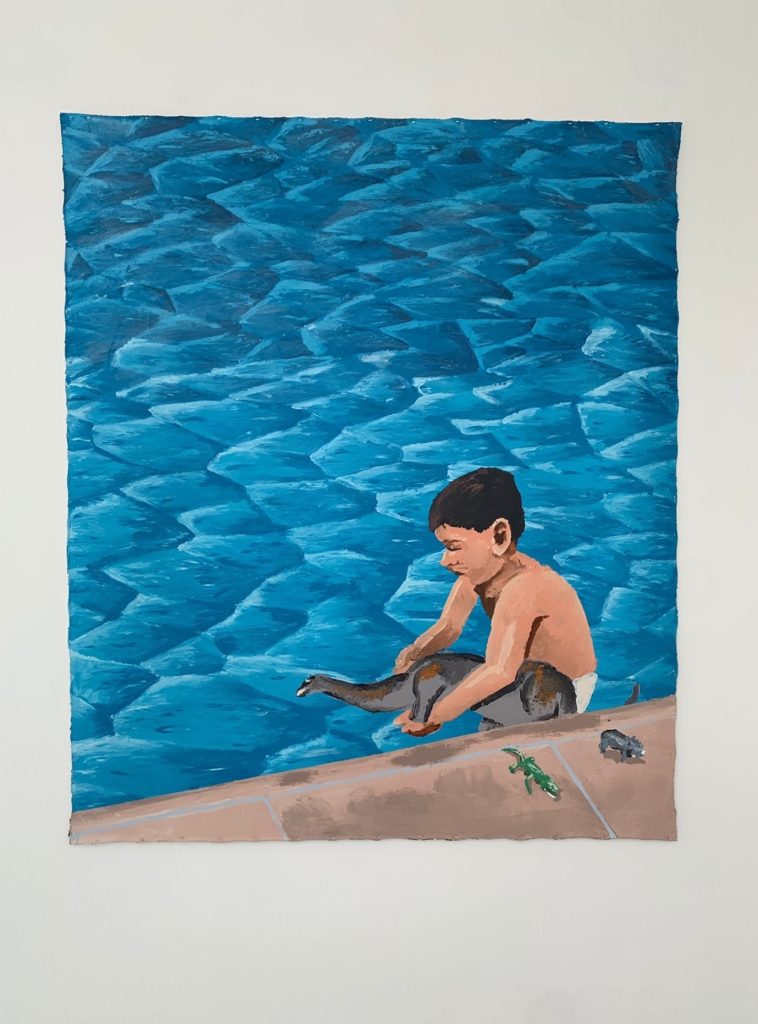THE TOP OF EACH RIPPLE
Manuel Solano
DCA until 20 November
The DCA publicity for Manuel Solano’s exhibition announces that their work ‘recalls and celebrates childhood moments impacted by formative influences like family, friendships, cinema, television and pop music’.
The gallery space utilises the contemporary white cube concept of display, (sanitized white walls, a spacious plan and a minimal bench allocation), and this also applies The Top Of Each Ripple. In such a space, each work is given ample room for undistracted observation and elevated by the context; yet the overwhelming expanse of white walls, may be also depriving the colours of the paintings to standout, negatively impacting the exhibition’s soft and nostalgic thematic.
As you approach the entrance, the intensity of the natural light from the ceiling windows illuminates the first gallery. On the left, two similar copies of the same scene are hung together: a dinosaur on a field with a crude depiction of a humanlike figure, a light blue sky in the background, all fingerpainted using acrylics. At first glance, Triceratops evokes infant imagery, the result of the primordial technique and style from the same visual language of the primary yellow-rayed sun, flat grey clouds, and green grass lines. This 2014 work from the series Blind Transgender with AIDS, is only one of the eleven paintings curated in the show, all produced after the artist’s loss of sight and supported by three film installations.
I usually rather experience an exhibition wanting to know very little biographical information about the artist or of the subject matter displayed as I feel that such contextual information can get in the way of one’s instinctive perception of the work of art. In this instance, however, acknowledging the artist’s disability empowers the pictures for questions on the purpose of art and curiosity of technique arise as I walk along the images.
El Chapoteadero, the other painting in the room, is technically different from Triceratops: stapled to the walls, a large-scale canvas sits slightly loose and shows a more clearly depicted scene where a young boy plays with dinosaur shaped toys in a swimming pool. Here are the geometrical waves of loud blues, innocent rigid lines in this depiction of a candid scene; the figure is beautifully lost in the expanse of the refreshingly blue painted waters which captivate.
The room is completed by a video work, played on a cube monitor. La Patita, a collection of colour-saturated video documents the artist’s childhood at home, at school performances, and so on, of a 80s-90s childhood. Viewed together with the audio available on earphones adds an extra dimension to this endearing melancholic vision. These exhibits show the innocence of the artist as a child; their simplicity and naïve frankness is clear in their adaptive artistic practice.
The first gallery sets a kindred tone and plays as an ‘amuse-bouche’ to the main gallery’s narrative. The latter is a much larger, spacious room, a touch sterile perhaps, and filled with just enough paintings of different scales to make you want to explore. Connecting the two galleries is a small dark grey room which projects a powerful, visceral contrast in subject; here the viewer is confronted with a large projection of the fifteen minutes video Masculina, subverting the initial experience in an instant. No more innocent child visions but instead, we see a raw portrait performance: adult Manuel flirts with us, sexual androgenous visions, exposing close ups of scars. ‘Who is gonna drive you home tonight?’, the voiceless tune reinforces the simile between Solano’s moving image, 80s pop video and American street life.
Overall, The Top Of Each Ripple offers intimate studies of the artist’s memories and affections, with tones and palette that provide a very primordial and innocent approach to their subjects. Without any curational information, some of the pictorial work might be easily lost as a school project. But the context reminds us of the difficulty of production, Solano is a blind artist, and with this knowledge the work on display is an intriguing and extraordinary insight into a visual artist who never gave up despite losing their vision.
The video work contrasts the painterly work, making you wish for more, as it stares back out at you, present in time, a silent confrontation.
As I exit towards the lively chat of the downstairs busy areas, I leave the quietness and haunting desolation of the art displayed, thinking how refreshing the painted water was, reminiscent of Hockney.
Francesca Tata





Leave a Reply